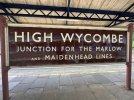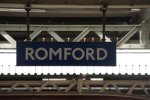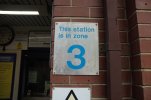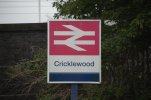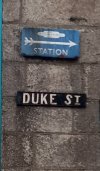-
Our new ticketing site is now live! Using either this or the original site (both powered by TrainSplit) helps support the running of the forum with every ticket purchase! Find out more and ask any questions/give us feedback in this thread!
You are using an out of date browser. It may not display this or other websites correctly.
You should upgrade or use an alternative browser.
You should upgrade or use an alternative browser.
Stations that still have BR era (or older) signage
- Thread starter sad1e
- Start date
Sponsor Post - registered members do not see these adverts; click here to register, or click here to log in
R
RailUK Forums
12LDA28C
Established Member
- Joined
- 14 Oct 2022
- Messages
- 5,058
Looking through my Photos from summer 2024 and found this photo of this sign at Romford (photo attached) , looks Like a BR sign to me , no idea if it is original or not though. it looked quite dirty and old when i saw it so i wouldn't be surprised if it is
Attachments
Class15
Established Member
There are quite a few of that kind of sign on generally unused (or not all that frequently used, as at Romford) fast line platforms.Looking through my Photos from summer 2024 and found this photo of this sign at Romford (photo attached) , looks Like a BR sign to me , no idea if it is original or not though. it looked quite dirty and old when i saw it so i wouldn't be surprised if it is
Another photo from summer , Cricklewood on the MML seems to still have an unkempt sign stating it being in zone 3 painted in NSE blue
== Doublepost prevention - post automatically merged: ==
the station seems to also have something taped over in blue tape on its sign. Any ideas what this could be , Thameslink 2000 or FCC branding perhaps ?
== Doublepost prevention - post automatically merged: ==
the station seems to also have something taped over in blue tape on its sign. Any ideas what this could be , Thameslink 2000 or FCC branding perhaps ?
Attachments
Sun Chariot
Established Member
Are the ones at High Wycombe, Hanwell and Kingham the originals? Or repro's?Of course High Wycombe station still has this famous original 'chocolate and cream' BR (W) sign in place...
View attachment 176155
Lowestoft still has a giant Eastern Region blue enamel "British Railways Lowestoft Central" sign.

 www.flickr.com
www.flickr.com
I think that the flickr caption is incorrect, the sign is original and has never been taken down, probably because nobody can work out how to remove it safely.

Lowestoft Central
Captured from a window out of the upstairs section of the Joseph Conrad, Lowestoft's Wetherspoon pub, is part of Lowestoft station. The station was refurbished in 2013, resulting in this sign being erected, referencing the long gone era of British Railways, when the station was known as...
I think that the flickr caption is incorrect, the sign is original and has never been taken down, probably because nobody can work out how to remove it safely.
Most MML stations south of St Alban's (minus Brent cross west because it's brand new) seem to have a decent amount of NSE blue signs left aroundAnother photo from summer , Cricklewood on the MML seems to still have an unkempt sign stating it being in zone 3 painted in NSE blue
== Doublepost prevention - post automatically merged: ==
the station seems to also have something taped over in blue tape on its sign. Any ideas what this could be , Thameslink 2000 or FCC branding perhaps ?
43096
On Moderation
- Joined
- 23 Nov 2015
- Messages
- 16,867
I think it is a TfL standard for their stations (primarily Elizabeth line) where there are platforms only occasionally used by TfL trains, e.g. Great Western main lines, or in the photo above the Great Eastern main lines.There are quite a few of that kind of sign on generally unused (or not all that frequently used, as at Romford) fast line platforms.
renegademaster
Established Member
Quite a lot of them signs along the Elizabeth line on the fasts , perhaps something to do with TFL rail when they took over the stations in 2015 , looks like the same font that London Underground usesThere are quite a few of that kind of sign on generally unused (or not all that frequently used, as at Romford) fast line platforms.
aftv
Member
AFIK it is the same typeface that TfL use. IIRC its called Johnston. So it could be a TfL Rail era sign. I think theres some stations on the GWML that have the same style of signs. Ealing Broadway springs to mind on the Fast Line platforms.Quite a lot of them signs along the Elizabeth line on the fasts , perhaps something to do with TFL rail when they took over the stations in 2015 , looks like the same font that London Underground uses
alxndr
Established Member
- Joined
- 3 Apr 2015
- Messages
- 1,603
I assume the spaced out letters at Bridgeton are old enough to qualify.


12LDA28C
Established Member
- Joined
- 14 Oct 2022
- Messages
- 5,058
Are the ones at High Wycombe, Hanwell and Kingham the originals? Or repro's?
Don't know about the others but High Wycombe is certainly an original. The enamel sign pictured was hidden for many years behind some poster boards and only came to light a few years ago when the poster boards were removed for replacement. As soon as it was discovered what was behind them, the old sign was cleaned up and remains on display to this day.
bluegoblin7
Established Member
Brand new sign in Johnston 100, as per TfL standards for the ‘alternative’ platforms on stations they manage.Looking through my Photos from summer 2024 and found this photo of this sign at Romford (photo attached) , looks Like a BR sign to me , no idea if it is original or not though. it looked quite dirty and old when i saw it so i wouldn't be surprised if it is
generalnerd
Member
Do they manage many alternative platforms (Stratford etc) as I feel like I’ve seen quite a few around LondonBrand new sign in Johnston 100, as per TfL standards for the ‘alternative’ platforms on stations they manage.
PG
Established Member
Ashley Hill
Established Member
We had a similar thread to this previously.
 www.railforums.co.uk
www.railforums.co.uk
== Doublepost prevention - post automatically merged: ==
Got around to photographing this pair of British Rail signs on the NR compound at Totnes.
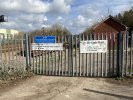
Latest appearance of early BR "coloured" station signs?
This has arisen from a post on the Whitby line thread. I remember seeing a photo of a DMU at Egton station which I think was dated late 70s, or perhaps very early 80s. The Egton station sign was not the standard black-text-on-white-background typical of this era, but a red/orange background...
== Doublepost prevention - post automatically merged: ==
Got around to photographing this pair of British Rail signs on the NR compound at Totnes.

Last edited:
Leyland Bus
Member
Those are lovely! It's quite incredible what seems to survive these days...We had a similar thread to this previously.
Latest appearance of early BR "coloured" station signs?
This has arisen from a post on the Whitby line thread. I remember seeing a photo of a DMU at Egton station which I think was dated late 70s, or perhaps very early 80s. The Egton station sign was not the standard black-text-on-white-background typical of this era, but a red/orange background...www.railforums.co.uk
== Doublepost prevention - post automatically merged: ==
Got around to photographing this pair of British Rail signs on the NR compound at Totnes.
View attachment 176315
https://flic.kr/p/2mvhzAG does this count? Found at Paddington a few years back unsure if this is pre nationalisation
Flange Squeal
Established Member
- Joined
- 17 Jul 2012
- Messages
- 1,551
Guildford also has a trace of Red Star Parcels still clinging on, with the tall BR logo sign on the corner of Walnut Tree Close and the Guildford one way system still having the red and yellow logo below it.A large Red Star Parcels sign can still be seen on the upper deck of Euston as you approach from the north.
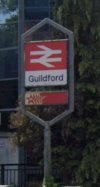
(Image shows Google Street View of the Guildford station double arrows logo sign with Red Star Parcels logo below)
Sad Sprinter
Established Member
Sadly, the NSE signage at Balham that was recently uncovered has now been painted over. I was hoping someone would try and salvage it.
Flange Squeal
Established Member
- Joined
- 17 Jul 2012
- Messages
- 1,551
The London end of Farnham platform 2 has a cast plate on the brickwork at wheel level facing platform 1 with wording along the lines of ‘Passengers must not cross the line’ (or similar). Sadly I don’t have a photo to hand, but the obvious age and style makes me believe it’s probably original London & South Western Railway (LSWR). I want to say I think I’ve seen one at Aldershot too.
GatwickDepress
Established Member
Is that First North Western banding on the bottom of the sign?At Congleton just off platform 1 there is a station name sign in lovely original rail alphabet, black on white. It's strange at Congleton as there are quite a few new signs in rail alphabet 2 but look carefully and there's 1 or 2 original rail alphabet ones still there.
My own photo below shows the Congleton station name sign in original rail alphabet, black on white, as described above. Looks a bit worn condition but still good to see.
Leyland Bus
Member
It is, which, along with the chunky double arrow, it's a post privatisation sign but cudos for it still having rail alphabet.Is that First North Western banding on the bottom of the sign?
A bizarre one but Network SouthEast put up a branded sign on the bridge where the South Eastern lines cross over Battersea Park Road, pointing down to "The Dogs' Home Battersea" alongside. It's been badly ruined by graffiti, but still there. Wouldn't it be nice if NR cleaned it up. Maybe Chris Green was a dog lover. It's here:

Peter Mugridge
Veteran Member
I'm sure there's a few of those around the network; I've seen one at least at Clapham Junction but I haven't looked for a while to see if it's still there.The London end of Farnham platform 2 has a cast plate on the brickwork at wheel level facing platform 1 with wording along the lines of ‘Passengers must not cross the line’ (or similar). Sadly I don’t have a photo to hand, but the obvious age and style makes me believe it’s probably original London & South Western Railway (LSWR). I want to say I think I’ve seen one at Aldershot too.
From memory it's on the platform 10 wall as viewed from platform 11.
Because it's the side entrance that not a lot of people use, basically they didn't know it was there so it's escaped all these years, but it is visible from the main (and busy) road.One that I drive past often that somehow escaped the change all these years.
The running in boards at Kingham used to be wooden, but I believe they've fairly recently (within the past few years) been replaced by fibreglass (?) ones. I assumed the wooden ones were the originals - the one on the up platform can be seen in this photograph from the www.hondawanderer.com website:Are the ones at High Wycombe, Hanwell and Kingham the originals? Or repro's?
Interestingly, there it's white with brown text, but at some point it was changed to white text on a black background for the main board piece. Here's a picture showing the wooden board on the up platform in 2014 - it wasn't in the best shape: http://www.hondawanderer.com/Kingham_Name_Board_2014.htm
The new boards have the same black background with white text as the wooden ones before them, and they look quite nice I think. I thought I had some photos but can't find them at the moment!
-Peter

A bizarre one but Network SouthEast put up a branded sign on the bridge where the South Eastern lines cross over Battersea Park Road, pointing down to "The Dogs' Home Battersea" alongside. It's been badly ruined by graffiti, but still there. Wouldn't it be nice if NR cleaned it up. Maybe Chris Green was a dog lover. It's here:

There is a sign on both sides of the bridge, one of which has a sponsored by message from a sign making company.
12LDA28C
Established Member
- Joined
- 14 Oct 2022
- Messages
- 5,058
https://flic.kr/p/2mvhzAG does this count? Found at Paddington a few years back unsure if this is pre nationalisation
If you mean pre-privatisation then yes it certainly has the appearance of a BR-era sign.

